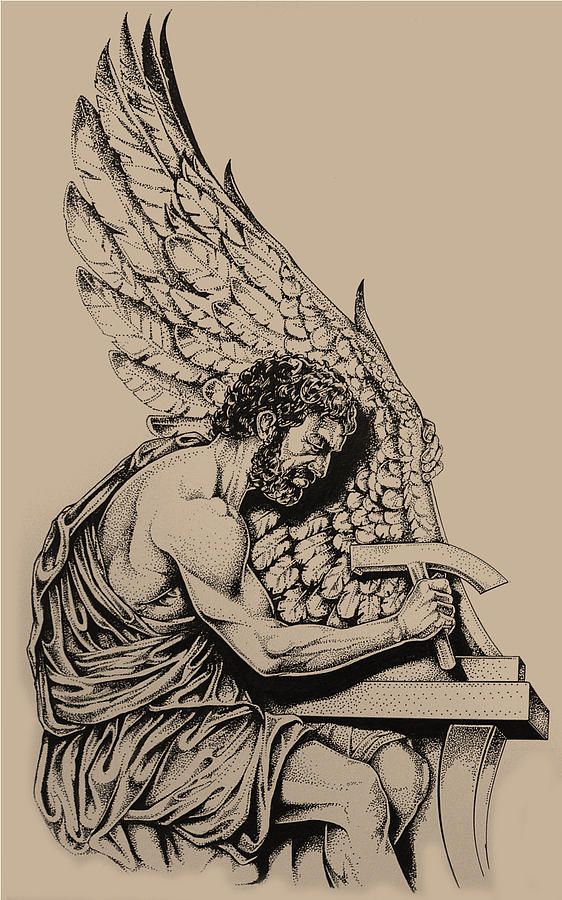Daedalus: the master craftsman
During one of our first celestial excursions (April 13th), we encountered Daedalus and his ill-fated son Icarus, the latter of whom perished after having flown too close to the Sun upon waxen wings. This tragic tale, one of the mythological Universe's best known, was but one event in Daedalus' storied and sometimes sordid career. Today, we revisit Daedalus and learn much more about his long life, impressive works and questionable character. Born the son of Eupalamus, an obscure figure known only for having been Daedalus' father, Daedalus was a bona fide child prodigy in both art and craftsmanship. It was said that even before reaching his teens, Daedalus was already "drawing from life," and had exhibited stunning ingenuity in his many inventions. Such was Daedalus' reputation that when he was still a young man, his sister Perdix asked him to take on her son, Calos, as an apprentice. Although Daedalus gladly agreed to do so, he soon learned that Calos' skills were comparable, perhaps even superior, to his own. For instance, one day as Daedalus and Calos were walking along a beach, the latter found a fish's spine on a rock. He took it home and reproduced its design in iron, thereby making a saw. By that time, Calos had already invented the geometrical compass and a potter's wheel. Realizing that his nephew would likely develop even more formidable skills that he could ever possess, Daedalus persuaded Calos to join him on a stroll along the top of a cliff outside of Athens. Once there, Daedalus pushed him off the edge. He would certainly have died had it not been for Athena. The goddess so adored Calos for his ingenuity that she transformed him into a partridge as he fell. For this reason one never sees a partridge flying at a high altitude for Calos forever after harbored a morbid fear of heights. Many Athenians witnessed Daedalus' act and he was promptly arrested, He was tried and convicted of murder, even though Calos didn't die, but was only transformed. Having taken into account the benefits Athenians derived from his many inventions, Daedalus was merely banished instead of being executed. He fled to Crete and entered the service of King Minos who soon found his services to be invaluable. Daedalus repaired much of the Cretan infrastructure, which had largely fallen into disrepair. He lived happily and comfortably in Crete for many years. During this time, he sired two sons, Icarus and Iapyx, on Cretian slave women. He raised both his sons to become his apprentices. Fortunately for them both, neither matched their father's abilities. Daedalus' life became considerably more interesting when Pasiphae, the King's wife, approached him one evening in desperation. She begged him to make her a cow suit as quickly as he could. Though perplexed by both the request and her strange earnestness, Daedalus constructed the suit at once, much to the queen's delight. What Daedalus didn't know was that Pasiphae had developed a mad lust for a beautiful white bull in her husband's possession. Poseidon had presented the bull to King Minos with the expectation that the king would sacrifice it back to the god. Instead, Minos became so enamoured of the bull that he decided to keep it for himself. The enraged Posiedon, being more creative in his revenge schemes that his thunderbolt-happy brother Zeus, punished Minos by casting a spell on his wife that caused her to ardently desire the bull. Hence, the necessity of the cow suit which she used to indulge her unnatural lust. From this coupling was born the dreaded Minotaur, a monstrous creature with a human underbody attached to a bull's head and torso. Horror struck at the grotesque baby's appearance, Minos ordered Daedalus to construct special housing for the creature to prevent its escape. Daedalus designed and built the famous labyrinth. So intricate were its twists and turns that nobody could escape from it, unless they knew the secret.
The Minotaur remained imprisoned in this complex maze. On Minos' orders, servants would push in a sheep, goat or other animal each day to satiate the creature. Once a year, however, the Minotaur dined on Athenian youth. Crete and Athens had once been at war and Crete prevailed. In order to maintain the truce that ended their conflict, Crete required Athens to send them fourteen young people (seven boys and seven girls) once a year. These tributes, as they were called, were herded into the labyrinth, never to be seen again. One year, Theseus, the son of Athenian king Aegeus, volunteered to become one of the tributes, for he was determined to become as great a hero as his cousin Heracles. When Theseus and the other Athenian youth arrived at Crete, Ariadne, Minos' daughter, fell instantly in love with him. She went hastily to Daedalus and asked him to tell her the secret on how to escape from the labyrinth. Daedalus told her that the only way to leave the labyrinth was to tie a skein of thread at its opening. A person would need to draw the thread along with him/her while moving through the maze. Only by following the thread back toward the entrance would the person manage to leave the labyrinth. Daedalus gave Ariadne a skein of thread before she left. She ran down to the shore where the tributes were about to enter the labyrinth. Ariadne rushed up to Theseus and said, "If you take me with you, I will tell you how to escape the labyrinth." Theseus agreed. Ariadne told him the secret and handed him the thread. Theseus entered the labyrinth, slew the Minotaur, worked his way out of the labyrinth with the other tributes and then left Crete in the company of Ariadne. (He abandoned her the next morning on the island of Naxos.) Realizing that the tributes could only have escaped the labyrinth with Daedalus' assistance, Minos had him locked in the labyrinth with his son Icarus. (Iapyx had already matured into adulthood and was living elsewhere.) As we learned in April, Daedalus fashioned wings out of birds' feathers and wax for both him and his son. Before they flew out of the labyrinth, Daedalus advised Icarus not to fly too close to the Sun. Unfortunately, Icarus didn't heed his advice. When he ventured too close to the Sun, the wax melted and the wings fell apart. Icarus fell to his death in the sea. Daedalus retrieved his son's body and buried him on the Icarian island, named for his ill-fated son. During the funeral ceremony, Daedalus was shocked to observe a partridge laughing at him in his profound state of grief. Then, in exile yet again, Daedalus moved to Sicily and entered the court of Cocalus, king of Camicus. Daedalus initially maintained a low profile for he rightly feared Minos. When he learned of Daedalus' escape, Minos resolved to find him no matter where he hid. The King then traveled to each kingdom and presented each ruler with a challenge. "I shall present a large sack of gold to anyone who can thread a seashell." For a while, no king took up the challenge for each of them believed the task to have been impossible. However, when arriving in Sicily, Minos met Cocalus and announced the challenge. Cocalus asked Minos to give him a day to work out the problem. Cocalus presented a seashell to Daedalus and asked him if he could thread it within one day. Daedalus immediately devised a solution. He sawed off the shell's apex and then tied a string to an ant. He then closed the apex until the ant progressed to the other opening. The seashell was threaded. Cocalus brought the threaded shell to Minos and explained how he managed to solve the problem. Minos knew at once that only Daedalus would have been clever enough to have figured out how to thread the shell. Minos told Cocalus that he knew that he harbored the fugitive named Daedalus. He also demanded that Cocalus hand him over within one day or his kingdom would be destroyed. Cocalus went promptly to Daedalus to explain the situation. Daedalus remained quite calm. "Invite him to dinner tonight," the craftsman suggested. Cocalus extended the invitation, which Minos readily accepted, for he expected to receive Daedalus during the dinner. Soon after Minos arrived at the king's court, he was told that dinner would, most unfortunately, be delayed. Minos was invited to bathe while awaiting dinner. Minos proceeded to the baths. As soon as he entered the tub, Cocalus' daughters maneuvered a pipe over him. At once, boiling water flowed through the pipe and onto the King, who perished in agony while the boiling water flowed over him. No longer in danger, Daedalus lived openly in Coalcus' court. By then he had become an old man whose innovations were few and far between. Despite his arrests, two exiles, the guilt of having murdered his nephew and the grief of having lost a son, in the end Daedalus lived and then died peacefully.
THE SOUTHWORTH PLANETARIUM
70 Falmouth Street Portland, Maine 04103
43.6667° N 70.2667° W
Altitude: 10 feet below sea level
Founded January 1970
Julian Date: 2459116.16
2020-2021: XVII
THE DAILY ASTRONOMER
Thursday, September 24, 2020
Remote Planetarium 95: Local Group Questions
Thank you! Thank you, subscribers for continuing to send excellent questions. One indictment of science is that every answer it produces prompts twenty other questions. Of course, scientific knowledge progresses because of the questions each new discovery generates. We are pleased to have so many questions, as well, so we can cover topics that were previously neglected.
"In that schematic of the local group, surely all the members do not lie on the same plane? Also, are the sizes of the spirals to the same scale as the distance?" -C.H.
You are correct. The galaxies are not located in the same plane.
The vertical lines connect the galaxies, themselves, to the reflected positions along the plane, defined by the Milky Way Galaxy's position.
Notice that the galaxy name labels are next to the galaxies, themselves.
The map is not intended to be a scale model by size.
Does the Local Group of Galaxies have a "shape," or is it just a lot of galaxies scattered about? -S.H.
Although the Local Group looks like galaxies floating in the void, the structure is actually dumb-bell shaped. At one end of the dumb bell one has the Milky Way Galaxy and at the other end the Andromeda Galaxy. Various satellite galaxies surround both these major galaxies. Other outlier galaxies are toward the "edge" of this Local Group. The membership of some of these outer galaxies isn't certain.
Is the Milky Way Galaxy ripping the Magellanic Clouds apart just like it is with the dwarf galaxies? -P.C.
As far as astronomers can determine, yes it is. We still don't know if the "clouds" have already passed through the galactic plane. However, we do know that the LMC and SMC will eventually torn asunder by the Milky Way Galaxy's tidal forces. The distance of both of these irregular galaxies from the Milky Way is about equal to the galaxy's diameter. Consequently, both of them are doomed....albeit in the very distant future.
Is the Local Group part of a bigger structure or is that as big as it gets? -K.S.
One would think that the Local Group of Galaxies would be big enough! Many more much larger structures exist. The Local Group of Galaxies is part of the Virgo Cluster. (We'll be proceeding to that level soon.) The image below shows the Local Group and other groups comprising this cluster.
To subscribe or unsubscribe from the Daily Astronomer:
"




